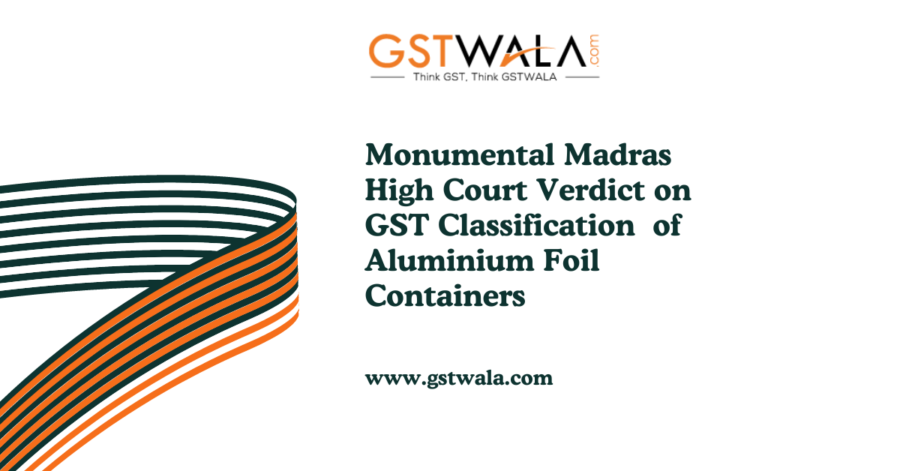
Monumental Madras High Court Verdict on GST Classification of Aluminium Foil Containers
Prepare to witness legal history in the making as the illustrious Madras High Court delivers a seismic judgment on the classification and GST rate applicability of Aluminium Foil Containers. Embroiled in the riveting legal saga of M/s. Veeram Natural Products v. The Additional Commissioner of GST and Central Excise dated September 13, 2023, this landmark case sends shockwaves through industries involved in such products. Brace yourself for an exhaustive exploration of this case, as we delve deep into its inception, pivotal facts, meticulous court analysis, and resounding conclusion, offering an unparalleled glimpse into the intricate layers of this legal dispute.
Background and Facts: Behold M/s. Veeram Natural Products, a trailblazing partnership firm specializing in the production and supply of Aluminium Foil Containers and Aluminium Foil in Roll Form, alongside an array of Plastic Articles. In the bygone era of pre-GST, these prodigious products were ensnared within the labyrinthine folds of the Central Excise Law, snugly nestled under Chapter heading 7607, and kissed by the duty rate of 12.5%. However, with the dawn of the GST regime, the petitioner boldly sought refuge under the benevolent shade of Chapter Heading 7615, beckoning forth a modest 12% GST rate. Yet, amidst this backdrop of transition, discordant voices arose, emanating from the revenue authority, vehemently advocating for their classification under 7607, shrouded in the ominous veil of an 18% tax rate, culminating in the issuance of the ominous Impugned Order.
The Issue: At the very heart of this titanic legal clash lay the insidious classification quandary engulfing Aluminium Foil Containers, torn asunder between the warring factions of Chapter Heading 7615 and 7607 of the Customs Tariff Act, thereby casting the die for the applicable GST rate.
Court’s Verdict: In a display of jurisprudential prowess, the Madras High Court unveiled a veritable cornucopia of pivotal determinations:
- Embarking on a Voyage of GST Taxation: With scholarly acumen, the Court unfurled the tapestry of GST taxation, intricately weaving the threads of “supply” as defined by the CGST Act. It meticulously sifted through the annals of relevant notifications and the Customs Tariff Act to unearth the hallowed grounds of goods classification under the GST regime.
- Embodied Precedential Prestige: Drawing upon the sanctified pages of legal precedent, the Court invoked the august presence of the Supreme Court in the seminal case of Hindalco Industries Limited Vs. CCE 2009 (237) ELT 588, where the classification dispute found sanctuary in favor of the petitioner.
- Classification Culmination: Armed with the arsenal of legal wisdom, the Court unhesitatingly decreed the hallowed classification of Aluminium Foil Containers under the esteemed banner of Chapter Heading 7615 of the Customs Tariff Act, thereby beckoning forth a modest GST rate of 12%. Thus, the Impugned Order was vanquished, relegated to the annals of legal obscurity.
- Refund Reverie: While tenderly acknowledging the petitioner’s tribulations, having borne the brunt of tax at the egregious rate of 18% for certain periods, the Court, in a gesture of judicial magnanimity, deferred the immediate resolution of the refund conundrum, holding it aloft as a beacon of hope for future adjudication in consonance with legal precepts.
The Madras High Court’s magisterial pronouncement in the case of M/s. Veeram Natural Products v. The Additional Commissioner of GST and Central Excise stands tall as a lighthouse of clarity amidst the tempestuous seas of the Aluminium Foil Containers classification imbroglio. By anointing Chapter Heading 7615 with the mantle of legitimacy and a modest 12% GST rate, the ruling sends shockwaves through the very fabric of industry. It serves as a clarion call to harmonize GST classification with the hallowed dictates of the Customs Tariff Act and pays obeisance to the sacred tenets of legal precedents in the resolution of contentious disputes. In summation, the judgment stands as an indelible testament to the pivotal role played by courts in interpreting tax laws and ushering in an era of certainty for businesses navigating the treacherous regulatory rapids.
Discover actionable insights and stay ahead of the
GST game with our comprehensive blog resources.
We are just a click away info@gstwala.comTop of Form
Top of Form
